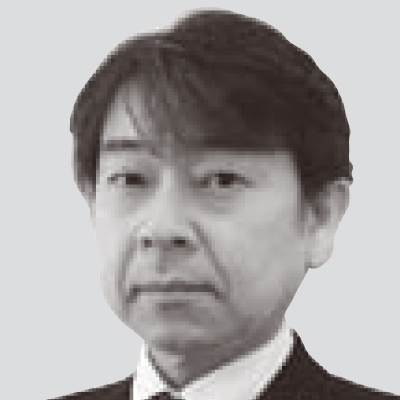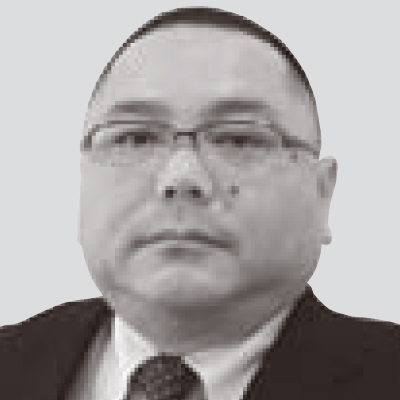Public and Social Infrastructure for Safe and Pleasant Cities
The environment in which we live is changing with each day and the roles required of security are also diversifying. Hitachi is contributing to building safe and pleasant cities by providing total solutions not only for detecting dangers or threats in real time, but also supporting making quick and accurate decisions and taking action.

Business Development Center, Market Development & Planning Department, Marketing Division, Defense Systems Business Unit, Hitachi, Ltd. Current work and research: Business development in the field of social infrastructure security.

Business Development Center, Market Development & Planning Department, Marketing Division, Defense Systems Business Unit, Hitachi, Ltd. Current work and research: Business development in the field of social infrastructure security.

Business Development Center, Market Development & Planning Department, Marketing Division, Defense Systems Business Unit, Hitachi, Ltd. Current work and research: Business development in the field of social infrastructure security.
In recent years, the environment in which we live has been changing with each day in response to terrorist incidents around the world, increased people flow on a global scale, and unprecedented natural disasters such as abnormal weather, and the roles required of security are also diversifying.
In urban areas, large-scale facilities such as airports and railway stations, and social infrastructure facilities, etc. that underpin our everyday lives, the typical monitoring method is to install security cameras and sensors in the target locations as required, and to monitor the information from a security center or security guard room. However, when using such methods, it is not possible to monitor all camera images at the same time. Even if all the video images can be displayed simultaneously, visual monitoring may lead to delays or omissions in the detection of dangers or threats. Further, in wide areas such as urban areas consisting of many buildings, the monitoring sites are often scattered between different buildings and areas. This makes it difficult to share security information between related facilities and to effectively utilize the information to avoid dangers.
This article describes total security solutions that perform real-time detection of a wide range of dangers and threats across wide areas such as social infrastructure and urban areas, and support a series of processes from assessing situations through analysis, determining the actions to take, and executing the actions.
To provide stable services for social infrastructure and safer and more pleasant cities in the face of threats such as terrorism and natural disasters, it is important to monitor by connecting multiple systems that were previously managed independently. Specifically, it is important to perform multifaceted monitoring of an entire monitoring area that encompasses multiple facilities via a shared interface that connects various sensors, including the utilization of existing equipment. The real-time analysis of these security camera images and sensor information enables incidents occurring within the monitoring area to be correctly identified and dangers to be detected in advance. In addition, this information is combined with a geographic information system (GIS) to assist decision making and information sharing, including know-how based on the observe, orient, decide, and act process, to provide an integrated monitoring solution for rapid and accurate decision making and action (see Figure 1).
The remaining sections describe solutions related to monitoring and analysis, and decision making and prompt action.
Figure 1—Overview of Total Urban Security Solution Using Integrated Monitoring System The security solution improves safety, security, and service quality by integrating and analyzing security camera images and various sensor data from the Internet of Things to detect suspicious persons or objects, or persons requiring assistance in real time, and responding rapidly to threats through action support solutions.
The security solution improves safety, security, and service quality by integrating and analyzing security camera images and various sensor data from the Internet of Things to detect suspicious persons or objects, or persons requiring assistance in real time, and responding rapidly to threats through action support solutions.
To detect abnormalities and take prompt action from a vast amount of monitoring data, it is important to analyze data in real time and to accurately assess an ever-changing situation. For example, video analysis enables the detection of suspicious persons attempting to enter a critical facility or a suspicious object that is left unattended for a certain period of time, and it also enables the identification of visitors who require assistance.
When infrared sensors are used for beam detection in conventional perimeter monitoring of critical facilities, false detections may occur for flying objects or small objects. In the case of sensors that detect fence vibration or tension, a ladder or other method can be used to avoid sensor detection, making it difficult to provide complete security measures.
In response to these challenges, Hitachi provides a perimeter monitoring solution that installs thermal cameras for perimeter monitoring to enable real-time intrusion detection through image analysis (see Figure 2).
This system analyzes the security camera images to detect persons, and if the person is in a prohibited area, it triggers an alarm and displays the location and detection image.
Thermal cameras convert thermal energy into video images, which means the impact of differences in brightness or between daytime and nighttime is small. Thermal energy is also very permeable, providing excellent visibility even in darkness, smoke, or fog. Further, each camera has a wide detection range, which minimizes the number of cameras needed for the entire system.
When an abnormality is detected, the actual video image can be visually checked to enable monitoring staff to make the final decision about whether the cause is an intruder or some other reason. This minimizes unnecessary dispatch of security personnel due to false detections. Hitachi is researching even greater improvements in detection accuracy through technologies such as deep learning.
Figure 2—Overview of Perimeter Monitoring Solutions for Critical Facilities Thermal cameras are used to enable perimeter monitoring that is effective even at night or in darkness, and in bad weather such as rain or fog.
Thermal cameras are used to enable perimeter monitoring that is effective even at night or in darkness, and in bad weather such as rain or fog.
In Japan and other countries, some security situations such as entrances to critical facilities or international conferences require the underside of vehicles to be inspected before they can enter. However, in many cases a visual inspection is done using a hand mirror, etc., which does not result in thorough examination. Other challenges include the time required for such inspections and the records that need to be kept.
Hitachi provides an under vehicle scanning system that can record clear images of the underside of a vehicle by simply placing the camera unit on the road and letting the vehicle pass over it (see Figure 3).
Further, images are taken not only of the underside of the vehicle, but also of the front and top of the vehicle at the same time. This enables the entire exterior of the vehicle to be inspected easily and accurately, while recording the data, including car registrations, in a database. To make the detection of abnormalities even more accurate, Hitachi is studying other functions such as inspection support that compares current data with past data and extracts the differences in order to indicate the locations of differences.
Figure 3—Overview of Under Vehicle Scanning System The camera unit is placed on the road and clear images of the underside of the vehicle are recorded when the vehicle passes over.
The camera unit is placed on the road and clear images of the underside of the vehicle are recorded when the vehicle passes over.
To ensure safety and security and more pleasant cities in the face of various threats, it is also important to determine how to quickly make accurate decisions and take action in response to identified situations. To do this, it is important not only that different organizations and businesses share information, but also that each facility and organization share its awareness and coordinate its actions.
In wide areas consisting of many facilities, such as urban areas, the current situation is such that communication between facilities is limited even though each facility has its own communication network. Also, not only in urban areas, but also in social infrastructure and other facilities, operations are often conducted while maintaining means of communication (extension phones, transceivers, etc.) according to each organization, such as security or facilities management, etc., with no communication or information sharing between these organizations.
As a means of improving this situation, Hitachi provides a multi-network interconnection system that integrates existing communication infrastructure and different communication methods such as cellular phones and wireless devices, and enables not only voice communication, but also data and video communication (see Figure 4).
This system enables normally impossible communication, such as between transceiver and telephone equipment, and between transceivers with different frequencies. It also makes it possible to communicate with multiple parties simultaneously, which enables simultaneous coordination between multiple facilities and organizations for rapid and reliable information sharing and issuing of response instructions. Hitachi also provides an interactive briefing system as a solution that enables data sharing of maps, drawings, and photographs on the information devices of onsite employees simultaneously with voice communication, and bidirectional input of handwriting, etc. for accurate and reliable information sharing (see Figure 5).
These solutions enable sharing not only of information, but also of situation awareness, to support accurate decision making and rapid action in response to various incidents.
In monitored areas such as urban areas and large-scale facilities, multiple organizations such as security or cleaning organizations are operating at any given time. For this reason, it is difficult to know and coordinate the positioning of personnel between different organizations. This is even more difficult in facilities where indoor and outdoor locations are mixed.
Hitachi provides a positioning solution that provides seamless positioning of outdoor and indoor locations. For example, when an employee is using a smartphone outdoors, positioning is performed via the global positioning system (GPS). Indoors, the current position is identified by receiving signals from beacons installed at the facility, and in the areas between sensors, positioning is performed by estimating the movement distance and direction through dead reckoning using accelerometers and gyroscopes.
Typically, beacons used for indoor positioning are powered by batteries. However, this requires periodic battery replacement, which creates a lot of work at large-scale facilities where many beacons are installed. To address this challenge, Hitachi is developing a solution that uses maintenance-free solar-powered autonomous beacons, which use power that can be generated even from the brightness level of indoor lights. Power storage devices provide power for nighttime operation (see Figure 6).
Knowing the position of each employee makes it possible to identify the employee closest to a detected abnormality, enabling rapid and efficient response. The solution not only records the current positions, but also records data such as movement routes, and congested locations and times. The stored data can be analyzed for use in improving operations or in the event of a natural disaster.
Also, using beacons not only for employees, but also for visitors to a facility provides data that can be used for a wide variety of applications, such as route guidance, marketing, or linking to equipment such as elevators, lights, and air conditioning, which can be expected to improve service quality (see Figure 7).
This article has described total security solutions for responding to diversifying security threats not only by detecting dangers, but also by supporting the next stages of decision making and taking action.
In an ever-changing social environment, the roles to be played by security operations will continue to evolve. Hitachi will continue to use new techniques and technologies such as artificial intelligence, etc. to advance its research in response to threats that will continue diversifying in the future. Hitachi will continue to provide solutions that improve services and help build safe and pleasant cities.